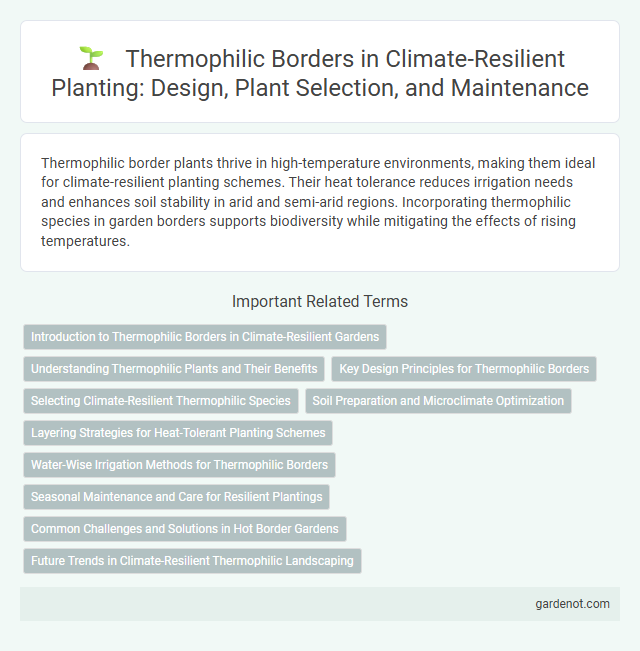Thermophilic border plants thrive in high-temperature environments, making them ideal for climate-resilient planting schemes. Their heat tolerance reduces irrigation needs and enhances soil stability in arid and semi-arid regions. Incorporating thermophilic species in garden borders supports biodiversity while mitigating the effects of rising temperatures.
Introduction to Thermophilic Borders in Climate-Resilient Gardens
Thermophilic borders incorporate heat-loving plants that thrive in warmer microclimates, creating resilient garden edges capable of withstanding temperature fluctuations and drought conditions. Species such as lavender, rosemary, and echinacea are commonly used for their high tolerance to heat and low water requirements, enhancing biodiversity while reducing maintenance. These borders not only stabilize soil and reduce erosion but also support pollinators essential for ecosystem health in climate-resilient garden designs.
Understanding Thermophilic Plants and Their Benefits
Thermophilic plants thrive in high-temperature environments, making them ideal for climate-resilient border planting. These species often exhibit drought tolerance, enhanced photosynthetic efficiency, and robust growth under thermal stress. Integrating thermophilic plants into landscaping not only mitigates heat effects but also supports biodiversity by creating habitats for heat-adapted fauna.
Key Design Principles for Thermophilic Borders
Thermophilic borders utilize drought-tolerant, heat-loving plants to enhance climate resilience by reducing water usage and improving soil stability. Key design principles include selecting native thermophilic species with deep root systems, ensuring plant diversity to promote ecosystem balance, and optimizing spatial arrangement for maximum sun exposure and air flow. Incorporating mulch and organic matter supports moisture retention and thermal regulation, contributing to long-term border sustainability under rising temperatures.
Selecting Climate-Resilient Thermophilic Species
Selecting climate-resilient thermophilic species requires evaluating plants' tolerance to high temperatures, drought resistance, and soil adaptability to ensure survival in warming climates. Species such as Aloe vera, Agave americana, and Opuntia spp. demonstrate robust thermophilic traits, promoting long-term stability in thermophilic border landscapes. Incorporating native, heat-tolerant plants enhances ecosystem resilience and reduces irrigation demands in climate-stressed regions.
Soil Preparation and Microclimate Optimization
Thermophilic borders require well-drained, nutrient-rich soil enhanced with organic compost to support heat-loving plant species. Soil preparation involves deep tilling and mulching to improve moisture retention and prevent temperature fluctuations, creating an ideal microclimate. Optimizing the microclimate through strategic plant placement and windbreaks ensures consistent warmth and reduces soil erosion, fostering climate resilience in thermophilic borders.
Layering Strategies for Heat-Tolerant Planting Schemes
Thermophilic border design employs layering strategies that combine heat-tolerant ground covers, mid-height shrubs, and tall canopy plants to create microclimates reducing surface temperatures and conserving soil moisture. Integrating species with varying transpiration rates optimizes evaporative cooling, enhancing resilience against heat stress and drought conditions. These stratified planting schemes boost biodiversity while maintaining functional ecosystem services in climate-resilient urban and agricultural landscapes.
Water-Wise Irrigation Methods for Thermophilic Borders
Thermophilic borders benefit significantly from water-wise irrigation methods such as drip irrigation and soil moisture sensors, which optimize water usage by delivering precise amounts directly to plant roots. Employing mulch and drought-tolerant plant species further enhances moisture retention and reduces irrigation frequency in thermophilic landscapes. These techniques improve water efficiency, promote plant health, and contribute to climate resilience in arid and heat-intensive environments.
Seasonal Maintenance and Care for Resilient Plantings
Thermophilic borders require regular seasonal maintenance to support plant resilience against temperature fluctuations and drought stress. Pruning, mulching, and soil aeration during spring and autumn optimize root health and water retention, enhancing plant adaptation to heat. Monitoring soil moisture and adjusting irrigation schedules prevent waterlogging and ensure optimal growth in heat-tolerant species.
Common Challenges and Solutions in Hot Border Gardens
Thermophilic borders in hot border gardens often face challenges such as intense heat, water scarcity, and soil degradation, which can hinder plant growth and yield. Solutions include selecting drought-tolerant, heat-resistant plant species, implementing efficient irrigation systems like drip irrigation, and enhancing soil organic matter to improve moisture retention and nutrient availability. Mulching and shading techniques further mitigate temperature extremes and reduce evapotranspiration in these climate-resilient planting zones.
Future Trends in Climate-Resilient Thermophilic Landscaping
Future trends in climate-resilient thermophilic landscaping emphasize the integration of heat-tolerant plant species that thrive under increasing temperatures and prolonged drought conditions. Innovations in genetic selection and soil microbiome management enhance plant resilience, optimizing water use efficiency and stress tolerance in thermophilic borders. Advancements in remote sensing and AI-driven analytics facilitate precise monitoring and adaptive landscape management, ensuring sustainable ecosystems in warming climates.
Thermophilic border Infographic

 gardenot.com
gardenot.com